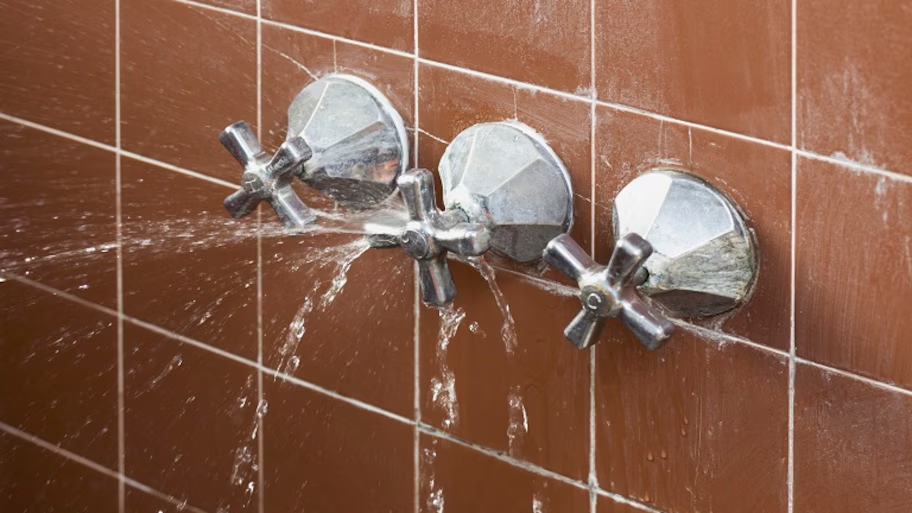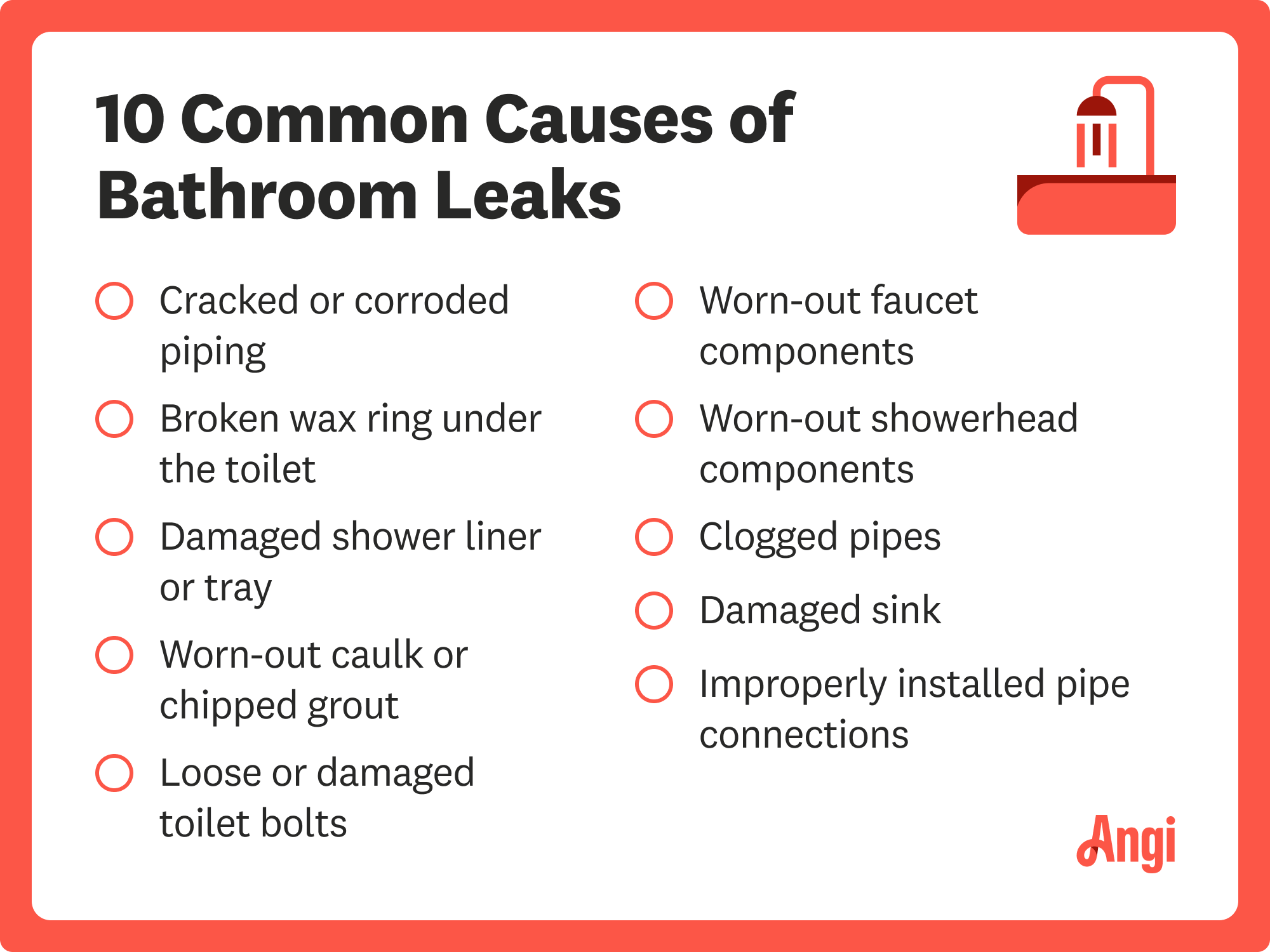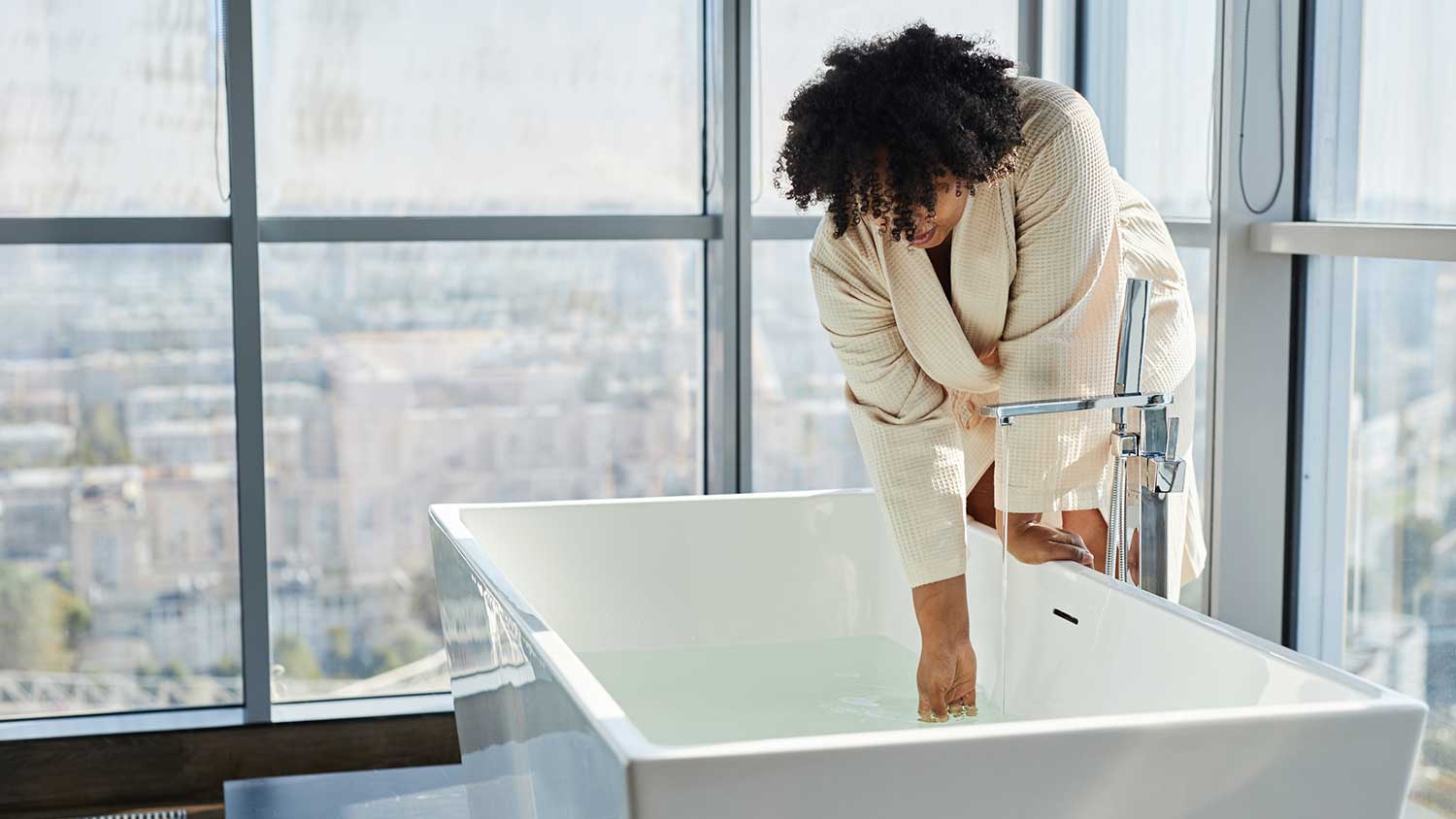
Learn about main water line repair costs in Columbus and what affects pricing to be prepared before you start getting estimates.
Look for telltale signs of a hidden bathroom water leak


Damaged or discolored walls, floors, paint, or ceilings are common signs of a leak.
A wobbly toilet could mean a broken wax ring.
Mold and mildew are other signs of a leak.
Water damage restoration costs $3,900 on average.
Fix bathroom leaks as soon as they happen to avoid water damage.
A hidden water leak in your bathroom can cause serious plumbing issues and mold if not identified and fixed. In addition to potentially causing expensive damage to the walls or flooring, a water leak can raise your water bill. But don’t stress—there are some telltale signs you may have a leak, so you can hire a plumber to take care of it before things get worse.
Have you noticed an earthy or musty smell in your bathroom lately, even after giving it a good cleaning? Don’t ignore this crucial sign of a potential water leak. (Or worse, simply try to cover it up with flowery air fresheners.) Keep looking for the hidden water leak, from inside your cabinets to behind your faucet, until you find the source.
Mold thrives in moist, dark areas. Pipes, which are hidden in a wall or under flooring, provide the perfect breeding ground. If you see mold or have an allergic reaction, like irritated eyes or wheezy breath, it’s possible you may have a hidden water leak. Investigate further and make sure to clean mold thoroughly so it doesn’t spread.
Keep in mind that it’s normal for a little mildew to occur wherever water accumulates, such as in the corner of a shower. However, mold or mildew on non-shower walls or in corners of the bathroom is a clear sign that water is leaking somewhere and finding its way to those areas.
If you see blistering paint or water stains on your pretty wallpaper, you could have a leak in the bathroom. Look at the floorboards, too. Some are like sponges and a little water damage will cause them to expand and warp quickly.
In most cases, steam from hot showers shouldn't cause paint to bubble or wallpaper to peel away. When water and moisture get between the wall and the paint, they weaken the stickiness. You might notice paint beginning to fall off in pieces or wallpaper coming loose. It’s possible to temporarily fix a pipe until you find a plumbing pro who can get there.
Another sign of a hidden bathroom leak is wall damage. When the drywall is exposed to moisture, it becomes soft and begins to bubble. Eventually, it will warp and break into pieces. To fix the leak, a plumber often must tear out the drywall, requiring someone to patch and paint when the plumber is finished. If it’s a bad leak, you’ll want to contact a local emergency plumber right away.
The only things you want hidden in your bathroom cabinet are extra rolls of toilet paper and cleaning products. But finding water or moisture in there is a sign of a hidden leak. It might be an easy fix, like tightening a nut, but it could also be a sign a valve needs replacing.
If your bathroom floor is buckling, cracking, or beginning to stain—and you didn’t let the bathtub overflow—odds are you have a leak. In this case, there could be a leak under your bathroom floor from a concealed pipe, or the water could have traveled there from another area.
You might notice the floor feels soft or spongy. You might even be able to pick up a tile right off the floor. Either way, it needs to be fixed to prevent any further damage.
A toilet should feel stable. If it starts to feel like a rocking horse, the wax ring that keeps a water-tight seal between the base and the pipe below could be worn. If you don't already see wastewater on the floor (and the foul smell to match), it’s likely only a matter of time before your toilet leaks from the base.

If the bathroom faucet is loose in your hand, water can seep into the gaps. To fix the issue, it might be as easy as applying new caulking to make it watertight again. Of course, a professional plumber can help diagnose the problem to ensure the leak is fixed properly.
If you have a bathroom on the second floor, check the patch of ceiling in the room directly beneath it for stains and signs of water damage. However, because water can travel a long distance, it's possible to find water stains on the ceiling further away.
An occasional wet floor in a second-story bathroom won't cause enough seepage to damage anything underneath it. But any brown, copper, or dark stain on the ceiling is a sign of a water leak in the ceiling. A sagging ceiling is a sign that water from a leak is reaching the area.
Any sign of water where there should be none is something to address ASAP. Knowing where to look (or smell) can help you catch hidden leaks early and prevent damage. Once you’ve found the source of the bathroom water leak, do the following:
Shut off the water to the faulty pipes or appliances.
Clear out any belongings that could get water damage.
Document the damage by taking photos or videos and writing down any key details.
Read the fine print of your insurance plan to see if your homeowners insurance covers water damage.
File a water leak insurance claim.
Repair the leak.
When you fix one leak, you'll usually find other leaks somewhere else in the system. A fix here reveals a problem there, and it's common to find a bigger issue coming from your leak.
It’s a good idea to call a plumbing repair pro near you when you see signs of a water leak in your bathroom—especially if that leak is more than a dripping faucet and could lead to significant water damage. It can be difficult to find hidden water leaks on your own, and they could have a complex cause. A plumber can find the source, assess the level of damage, and make the most appropriate repair without the guesswork of a DIY.

Some homeowners with plumbing experience may be able to make minor repairs, like fixing damaged caulk or replacing a leaky P-trap, but don’t attempt a DIY unless you’re totally comfortable. You could end up spending more on water damage than you would on a professional repair in the first place. If you suspect a leak in a bathroom wall or see water under the bathroom floor, leave it to the pros.
If you see water under your bathroom floor, it’s already too late. Life happens and pipes do eventually wear down and can spring a leak. The best course of action to fix serious leaks is to prevent them from happening in the first place. Here are some ways you can prevent issues before they begin:
Inspect your plumbing system for worn-down pipes, fixtures, and connections.
Replace corroded or aging pipes before they spring a leak.
Regularly check your caulk and grout for damage and make repairs when necessary.
Upgrade plastic water supply lines to stainless steel.
Make prompt repairs when you notice problems before they turn into a leak.
Use a strainer and regularly clean your drains to prevent clogs.
Do not flush anything but toilet paper down your toilet.
Invest in a smart leak detector.
Address small water leaks before they become big problems.
The average bathroom leak repair costs $275, but most jobs range from $150 to $600. If you have a complex repair, like a burst pipe, you could spend up to $4,000. Water damage restoration is one of the most costly parts of the job at an average of $3,900. You’ll spend between $4 and $7 per square foot for the water cleanup, plus the cost of drywall, flooring, or fixtures you need to replace.
If you want to pay the most exorbitant prices possible for your job, this is the company for you. “By the job” pricing is a rip-off, at least how these people use it. Every job is plugged into a category and prices are set by category. You might have a job that takes half an hour or one that...
Matt is a consummate professional. The work turned out to be far more difficult than expected and rather than turn the job down, Matt rose to the occasion and completed a near impossible task. I can not recommend Greene's Plumbing Service more highly. On a scale of 1-5 I would give Matt a...
Very professional and efficient with work. Answered each question I had with great knowledge and an informative response. Will be working with them again.
Window Depot did an amazing job on my deck. I wasnt sure what I wanted to do, but their composite decking was affordable and will last a long time. I am excited to have family over, and I am no longer embarrassed by my backyard. Jeff and the ground crew were polite, respectful, and caring for...
We used Unique Hardwood Floor LLC three years ago to work on the floors of a 70 year old home that needed a great deal of work. Some floors needed repairs, some were replaced and others just needed to be refinished. It was a complicated job as they needed to blend the old and the new to...
Involved an extensive bathroom remodel, including removing tub & installing walk in shower, new drywall, custome tile work to ceiling, plumbing, etc. Overall, job was done on time and on budget. Nick & his team were very professional and had high attention to detail. Quality was great. Highly...
The initial quoted price from a walk-through seemed high, but we discussed that the quote represented worst case scenario (re-wiring to two floors) and we were excited about the opportunity to have the work done in a timely manner with closing for fire safety reasons, etc. When the job was...
Very professional. Explained what they were doing and what we need to do to keep system running well. Will use them again for plumbing and HVAC services
I've been around the block myself many times and know most of the lingo, angles, tricks and traps of contracting work on a home. And, I've taken the community school contracting licensing classes and heard contractors discuss openly and candidly trade practices and tales both good and bad. ...
From average costs to expert advice, get all the answers you need to get your job done.

Learn about main water line repair costs in Columbus and what affects pricing to be prepared before you start getting estimates.

Discover the leading factors affecting your main water line replacement cost in Columbus, including length, material selection, and installation details.

Learn how much plumbers cost in Columbus, Ohio. Discover pricing for faucet repairs, pipe work, and emergency services, plus how you can save money.

Wall-hung toilets offer a modern style and are easy to clean, but they’re also expensive and difficult to repair. Let’s examine the pros and cons of wall-hung toilets.

Frozen underground pipes can lead to costly damage to your home. Use this guide to learn how to safely thaw them, prevent future freezes, and protect your home from expensive water damage.

Most homeowners will eventually need to replace bathroom hardware. This guide breaks down bathtub faucet installation costs, so you can upgrade your bathroom.